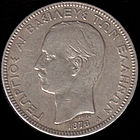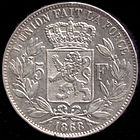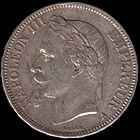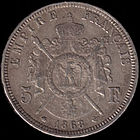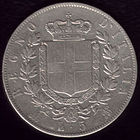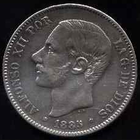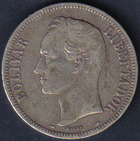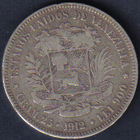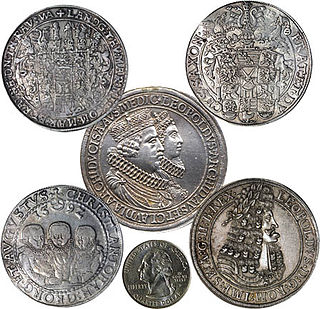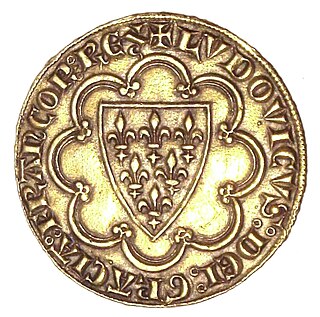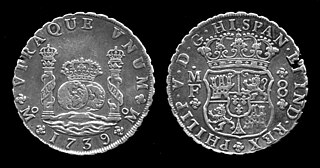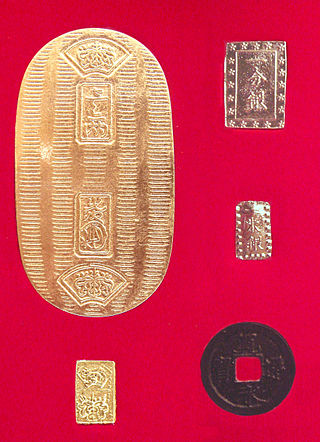History

Preliminary context
The LMU adopted the specifications of the French gold franc, which had been introduced by Napoleon I in 1803 and was struck in denominations of 5, 10, 20, 40, 50 and 100 francs, with the 20 franc coin (6.45161 grams or 99.5636 grains of .900 fine gold struck on a 21-millimetre or 0.83-inch planchet) being the most common. In the French system the gold franc was interchangeable with the silver franc based on an exchange ratio of 1:15.5, which was the approximate relative value of the two metals at the time of the law of 1803. [2]
Initial treaty
| Denomination | Composition | Mass | Diameter |
|---|---|---|---|
| 1 centime | Bronze | 1 g | 15 mm |
| 2 centimes | Bronze | 2 g | 20.2 mm |
| 5 centimes | Bronze | 5 g | 25 mm |
| 10 centimes | Bronze | 10 g | 30 mm |
| 20 centimes | Silver (.835) | 1 g | 16 mm |
| 50 centimes | Silver (.835) | 2.5 g | 18 mm |
| 1 franc | Silver (.835) | 5 g | 23 mm |
| 2 francs | Silver (.835) | 10 g | 27 mm |
| 5 francs | Silver (.900) | 25 g | 37 mm |
| 10 francs | Gold (.900) | 3.2258 g | 19 mm |
| 20 francs | Gold (.900) | 6.45161 g | 21 mm |
| 50 francs | Gold (.900) | 16.12903 g | 28 mm |
| 100 francs | Gold (.900) | 32.25806 g | 35 mm |
By treaty dated 23 December 1865, [4] France, Belgium, Italy, and Switzerland formed the Latin Monetary Union. They agreed to a combined gold and silver standard (bimetallism) with a gold-to-silver ratio of 15.5 to 1 as established in the French Franc. One LMU Franc represented 4.5 grams (69 grains) of fine silver or 0.290322 grams (4.48035 grains) of fine gold.
The treaty required that all four contracting states strike freely exchangeable gold coins and silver coins according to common specifications. Before the treaty, for example, the fineness of the silver coins in the four states varied from 0.800 to 0.900. The treaty required that the largest silver coin of 5 francs be struck 0.900 fine and the fractional silver of 2 francs, 1 franc, 50 centimes and 20 centimes all be struck at 0.835 fine. [4] The agreement came into force on 1 August 1866. [5]
The LMU served the function of facilitating trade between different countries by setting the standards by which gold and silver currency could be minted and exchanged. In this manner a French trader could accept Italian lire for his goods with confidence that it could be converted back to a comparable amount of francs.
Further joining members
Following the International Monetary Conference of 1867, the original four nations were joined by Greece on April 10, 1867. [6] Greece took advantage of a clause in the treaty that guaranteed admission of foreign states that agreed to abide by the treaty. Spain and Romania also considered joining. The discussions broke off unsuccessfully, but both countries nevertheless made an attempt to conform their currencies to the LMU standard. [6] Austria-Hungary refused to join the LMU because it rejected bimetallism, but signed a separate monetary treaty with France on December 24, 1867 whereby both states agreed to receive into their treasuries one another's gold coins at specified rates. [7] Austria-Hungary thereafter minted some but not all of its gold coins on the LMU standard, including the 4 and 8 florin, which matched the specifications of the French 10 and 20 francs.
Other states later adopted the system without formally joining the treaty: The colonies of France (including Algeria) came under the scope of the treaty in 1865; Peru adopted the franc system by law on July 31, 1863; Colombia and Venezuela followed in 1871; the Grand Duchy of Finland adopted the system on August 9, 1877; Serbia on November 11, 1878; and Bulgaria on May 17, 1880. [8] Coins struck for the Spanish territory of Puerto Rico in 1895 adhered to the standard, with one peso to five Spanish pesetas. [9] In 1904, the Danish West Indies were also placed on this standard but did not join the Union itself. When Albania emerged from the Ottoman Empire as an independent nation in 1912, coins of the Latin Monetary Union from France, Italy, Greece, and Austria-Hungary began to circulate in place of the Ottoman Lira. Albania did not however mint its own coins, or issue its own paper money until it adopted an independent monetary system in 1925. [10]
With the tacit agreement of Napoleon III of France, Giacomo Antonelli, the administrator of the Papal Treasury, embarked from 1866 on an ambitious increase in silver coinage without the prescribed amount of precious metal, equivalent to Belgium's total. [11] [5] The papal coins quickly became debased and excessively circulated in other union states, [lower-alpha 1] to the profit of the Holy See, but Swiss and French banks rejected papal coins and the Papal States were ejected from the Union in 1870, owing 20 million lire. [5]

